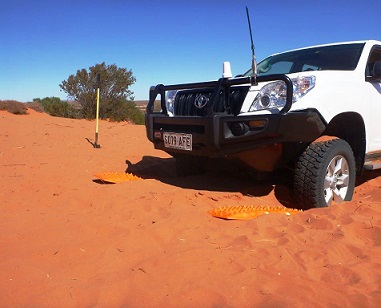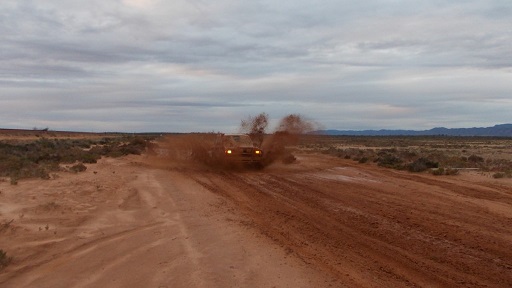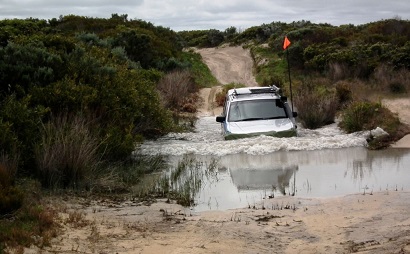Off Road Driving – Types, Tips & Techniques
It’s a sad fact that many 4WD’s never make it off the road these days. Getting a little sand or mud on the tyres and experiencing off road driving is  what makes a 4WD worth having! But if you’ve never been off road driving before, there’s a few things you need to know.
what makes a 4WD worth having! But if you’ve never been off road driving before, there’s a few things you need to know.
Different Terrains call for different Off Road Driving Techniques
There are different styles of off road driving and it’s sometimes surprising how many people approach off road driving in exactly the same way that they approach driving on a highway. However the skills you need to drive on a highway are very different to those needed for sand, rocks or mud and they each require different techniques when you’re driving and when you’re stuck.
If you’re new to off road driving, then it is worthwhile getting some professional 4wd training before you hit the tracks so that you can learn how to safely navigate and extricate yourself from potentially dangerous situations. Here are some of the more common styles here in Australia.
Sand Dune Driving
While many coastal areas are protected in order to maintain their fragile eco system, there are still a few places where you can go sand dune driving. Before heading off though, it’s a good idea to make sure you know how to drive in sand. For starters, it’s essential to reduce the air pressure in your tyres. If your tyres are usually around 38psi, then for sand dune driving, you’d look at reducing them to around 12 – 14psi.
 Mud Driving
Mud Driving
Mud driving is off road driving through an area(s) of wet mud or clay. Its difficulty lies in getting through without getting stuck and you can buy tyres specifically designed for mud driving or a good All Terrain with an aggressive side wall (with good Side biters) in order to decrease this chance. Beware though – once you’re stuck, getting out can be a messy business!
Rock Crawling
Sounds fairly straightforward but it’s an art best learned from someone experienced in rock crawling, rather than trying to learn it on the fly. Understanding wheel placement, correct tyre pressures for rocky terrain, ground clearance, avoiding obstacles and traction all come into play when you’re driving in rocky terrain and it’s best done slowly, to avoid damaging the drivetrain of your vehicle.
Outback Travelling or Overlanding
A very popular form of off road driving in Australia and can combine elements of all of the above styles of driving. Usually undertaken in remote areas with little mobile phone coverage, it’s best to undertake Outback off road driving in a convoy or with at least 1 other vehicle, especially if you’re heading into unknown territory.
Always remember that off road driving is about having fun, but there’s nothing fun about writing off your vehicle 500 kms from help. The most important elements of any off road driving adventure is safety & preparation, so here’s a few things to keep in mind before your next
Bare Essentials
It’s essential to ensure that you have a full tank of fuel and (if possible) extra fuel and water. As well as that, you should always include a tow rope that is rated heavy enough for your vehicle, a portable air compressor, a spare tyre and any equipment you will need to change the tyre in the field, a good first aid kit (make sure nothing is out of date or empty), mobile phone & navigational aids.
If possible, you should also take a high lift jack, shovel, vehicle mounted winch, UHF Radio & a fire extinguisher.
Drop Tyre Pressure
Lower tyre pressure will give you improved traction in nearly every off road driving experience. When you decrease the pressure of your tyres, you allow the sidewall and tread of your tyres to flex more and mould itself to rocks and uneven terrain. In doing so, you get more grip and incidentally, a better ride. If you’re driving on sand, the lower pressure allows you to ride on top of the sand rather than digging in and getting stuck.
Get a Grip
This applies in 2 ways.
- Never put your fingers inside the steering wheel, always keep your thumbs up on the outside, so that if the steering wheel kicks, you won’t end up with sprained or broken thumbs. It’s the best and safest grip when driving;
- When you feel your tyres spinning, it’s instinctive to hit the throttle but it’s usually not helpful. A better solution is to ease off the accelerator and start turning your steering wheel back & forth. Doing this gives your tyres a chance to dig in to fresh patches of dirt or grip the clean side of any rock, sand or mud in order to pull you out.
Reading the Terrain
The last thing you want is to be surprised by a potentially dangerous stretch of the track. If you’re not sure about what you’re facing, stop the vehicle in a safe place and get out of the vehicle to inspect the terrain on foot. It’s always better to get a feel for what you’re facing than to run in blind. If you’re following someone else, watch how they navigate the same stretch, chances are, you’ll learn 1 of 2 things from them – what to do, or what not to do. So, remember – Stop, Get Out and Look….Think, Assess and Decide!
 Waters Crossings
Waters Crossings
If you are going to attempt to cross water, there are several things to keep in mind –
- How well do you know your vehicle? Where is the air intake? Where is the on board computer located? Generally speaking, you don’t want to submerge either of these things if you can help it. If you don’t know where they’re located, you don’t how how deep you can take the vehicle without risking a breakdown.
- Once you’re committed, the only way is (usually) forward. Most people run into trouble when they decide they shouldn’t have entered the water in the first place. The problem is that this moment of clarity comes too late – usually at about the time the water is level with the windows or higher. Once the water is that high, you don’t have a lot of choice. Stopping – even to change gear and put the vehicle in reverse and you’re going to flood your engine, which means you won’t be going anywhere but where the current takes you. There’s a very good way to prevent this…
- Check the depth of the water. Hop out of the vehicle, get a branch or stick and check the depth. You might get your legs wet, but if you’re 1 meter from shore and ankle deep when you discover the ledge disappears and drops off to be several meters deep, you’re going to think getting your feet wet was worth it. It also gives you a chance to gauge the current and decide if it’s safe or not. The worst place to decide the current is too strong to cross is midway, better to realise this beforehand.
- Don’t be afraid to avoid the crossing. If you’re not sure, back away. You can always drive up or down stream to find a safer crossing point. You can always find a safe spot on higher ground to camp for an extra night while you wait for water to subside. What you can’t do is turn back the clock. Know your vehicle. Know your capabilities. Respect the water. Do this and you’ll be far safer than if you assume ‘she’ll be right mate’.
If you’d like some professional 4wd training to prepare you for your next off road driving adventure, contact us for more information.

 Mud Driving
Mud Driving
 Waters Crossings
Waters Crossings